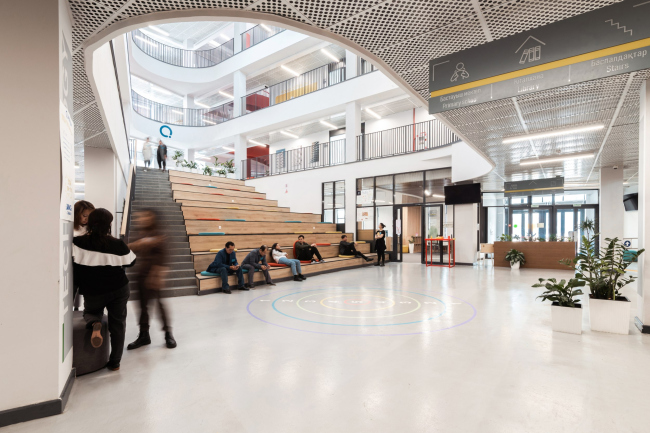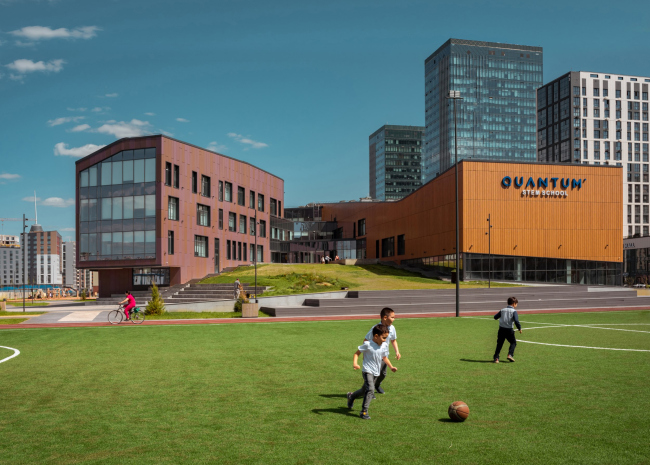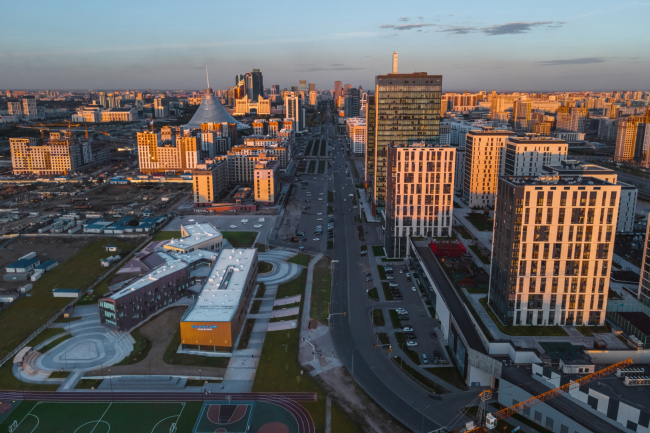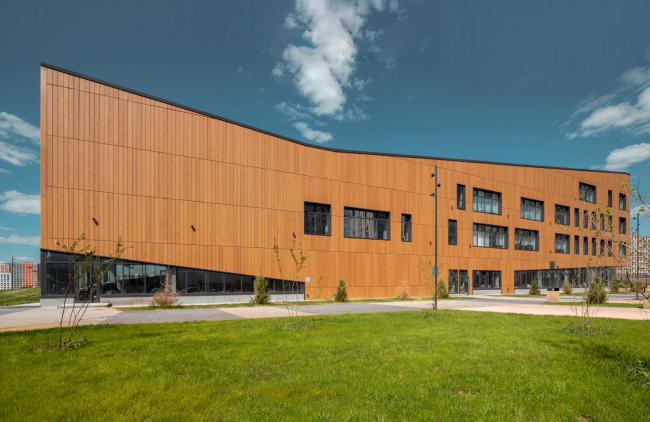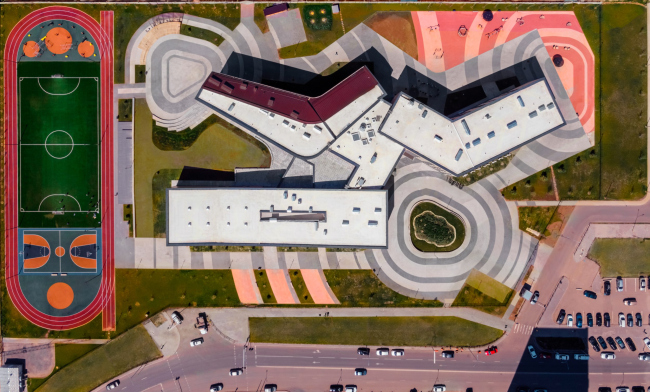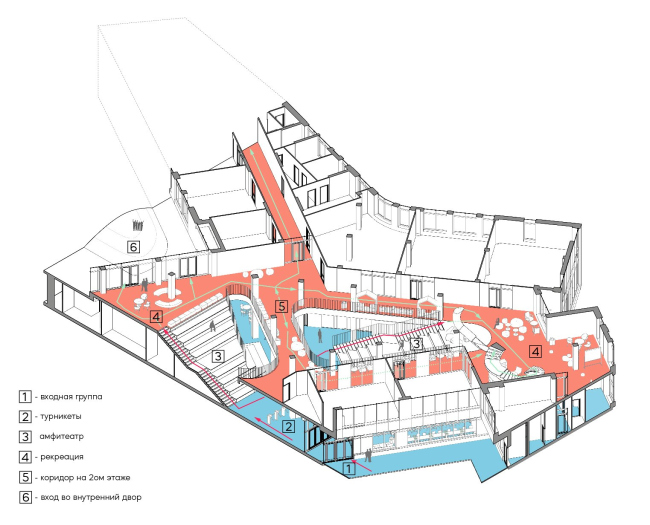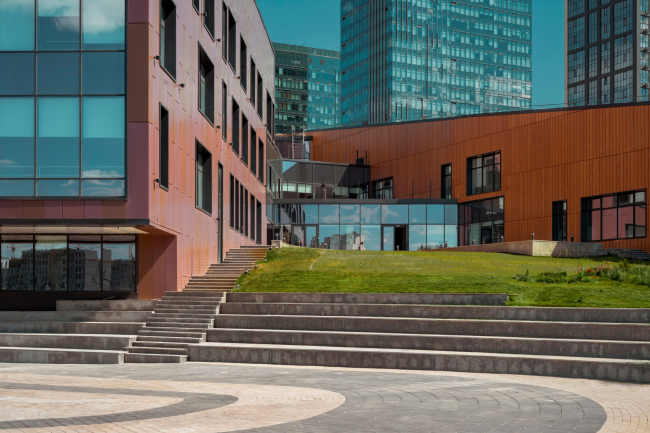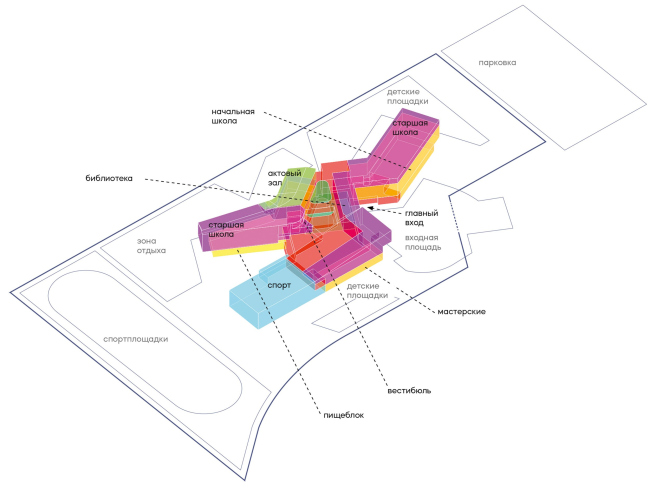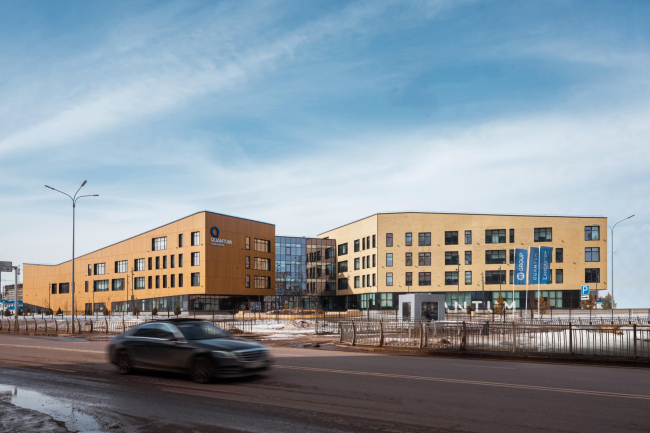|
Published on Archi.ru (https://archi.ru) |
|
| 14.02.2023 | |
|
A School of Our Time |
|
|
Julia Tarabarina |
|
| Architect: | |
| Vera Butko | |
| Anton Nadtochiy | |
| Studio: | |
| ATRIUM | |
|
On the eve of the presentation of the new book by ATRIUM, dedicated to the design of schools and other educational facilities, based on the architects’ considerable experience, as well as expert judgments, we are examining the Quantum STEM school building, constructed according to their project in Astana. Furthermore, this building is planned to be the first one to start a new chain. The architects designed it in full accordance with modern standards but sometimes they did break away from them – only to confirm the general development rules. For example, there are two amphitheaters in the atrium, and there is an artificial hill in the yard that is meant to make the flat terrain of the Kazakhstan steppe more eventful. The Quantum STEM school in Astana is the first complete building of this private school network in Kazakhstan. Its principles are most modern and cutting-edge: to inspire, to develop, and to motivate the students, among other things, for “intellectual adventurism”. Also, the schools will pay special attention to technological disciplines and natural sciences, while instruction will be given in three languages: Kazakh, Russian, and English. Private school QUANTUMCopyright: Photograph © Evgeny Tkachenko / provided by ATRIUM ArchitectsPrivate school QUANTUMCopyright: Photograph © Evgeny Tkachenko / provided by ATRIUM ArchitectsOne of these days, ATRIUM are presenting a book based on examples from their own practice of designing school buildings, as well as experts’ reviews and other materials – some sort of compendium on the issues of working with educational institutions. The architects have a tremendous 20-years’ experience in that, starting with the orphanage school in Moscow’s Kozhukhovo. The Quantum school in Astana is the newest of the buildings designed by ATRIUM, whose construction is now complete, and this is why we decided to give a detailed coverage of this project now. And we do recommend reading the book too. 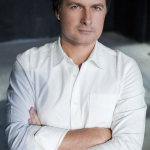 Anton Nadtochiy, ATRIUM So far, we have worked on the concepts of three buildings within the Quantum STEM network of private schools. Schools in Almaty and Shymkent are still in the design stage, the building in Astana has been built in a surprisingly short time, from the delivery of the concept to the completion of construction and the start of the school in September 2021, only 9 months passed, which is very little. All the three projects are different, they are by no means “standardized”, and their architecture is highly individual; perhaps they are united by a common approach – in each case, volumes with different functions look different, but they “bleed together” through the public space of the atrium, which becomes the basis for movement and communication, and by spaces “flowing” into one another, which makes their perception more complex, and therefore interesting. The task that was set for us in the case of a school in Astana was not exactly “exceptional”, but it was very close and interesting to us – all we were required to do was design a school based on the requirements of modern education: with a space that ensures de-confliction of streams, in particular, middle and high schools (children study here from the 6th grade) – and at the same time provides opportunities for communication, multifunctional use and creates a variety of ways of movement. For example, in this case, it is possible to reach the ground level from both first and second floors, and at the same time, the artificial hill creates – on a completely smooth and even terrain of Astana – a courtyard protected from the wind, not to mention the fact that the hill now commands sweeping views. Another feature is that in Astana we have not one, but two amphitheaters in a common atrium space, such a solution is not very common. We also liked the client’s desire to make the building cutting-edge, convenient and relevant, without any specific references to national culture. The school was built very fast, within 9 months. The ATRIUM architects developed the concept and consulted the Kazakh company that prepared the working documentation. It is only the interiors that were executed without the architects’ direct supervision, even though all the key ideas were also implemented here. On the whole, the authors are happy with the end result, even though they do not conceal their surprise at the incredible rate of its implementation. The school is located in the center of Astana, next to the central, regularly planned parks of the new capital. Norman Foster’s Khan’s Tent is 800 meters to the east. Nearby, across the street, there is a residential complex; the city in this part is growing and developing. Private school QUANTUMCopyright: Photograph © Evgeny Tkachenko / provided by ATRIUM ArchitectsThe building in fact consists of three units: the sports one stretches by the south border of the site; its elongated volume, coated with panels the color of warm yellow wood, has a roof that elevates towards both ends, so, when viewed from an angle, this unit looks a little bit like a swing, the effect being further strengthened by the glazing that expands from east to west. Private school QUANTUMCopyright: Photograph © Evgeny Tkachenko / provided by ATRIUM ArchitectsPrivate school QUANTUMCopyright: Photograph © Evgeny Tkachenko / provided by ATRIUM ArchitectsThe two academic units: the western one (meant predominantly for grades 6-9), and the eastern one (meant for higher grades), are also bent like “bird signs”, each “spreading its wings”, which is clearly visible on the plan or drone footage. Private school QUANTUMCopyright: Photograph © Evgeny Tkachenko / provided by ATRIUM ArchitectsAll the three units are connected by an atrium, and at this point we are remembering Anton Nadtochiy’s words that the atrium here is not just large, but also far from simple. It has two amphitheaters in it, veering up and to the sides from the central space; on the level of the second floor, there is an overpass that connects them. In the upper part, however, the amphitheaters develop in different ways. One of them is larger, and the third and fourth floors encircle it in galleries. The other amphitheater is smaller. In the ceiling of the third floor above it, there is a triangle with a trampoline. All the extra safety measures have, of course, been observed, including double safety nets, and the experience of jumping on the trampoline will probably be unforgettable. 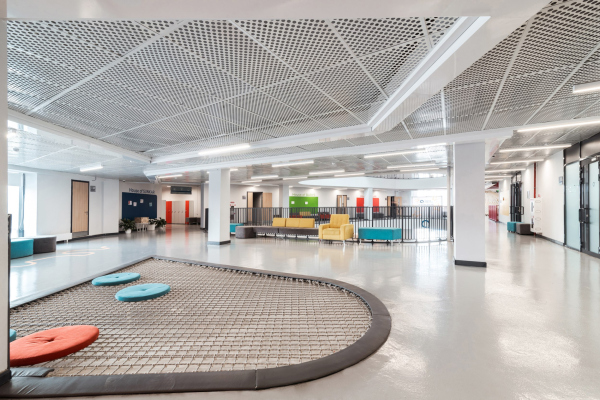 Private school QUANTUMCopyright: Photograph © Evgeny Tkachenko / provided by ATRIUM Architects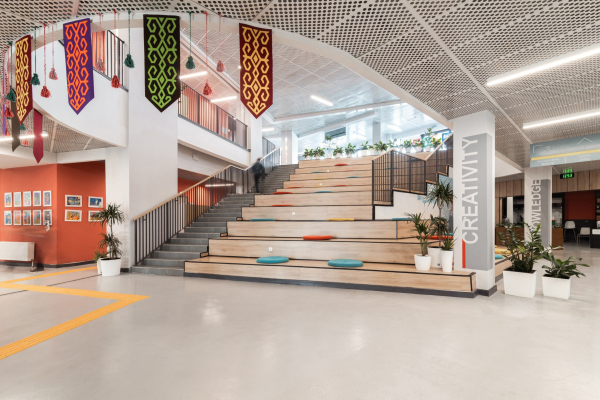 Private school QUANTUMCopyright: Photograph © Evgeny Tkachenko / provided by ATRIUM Architects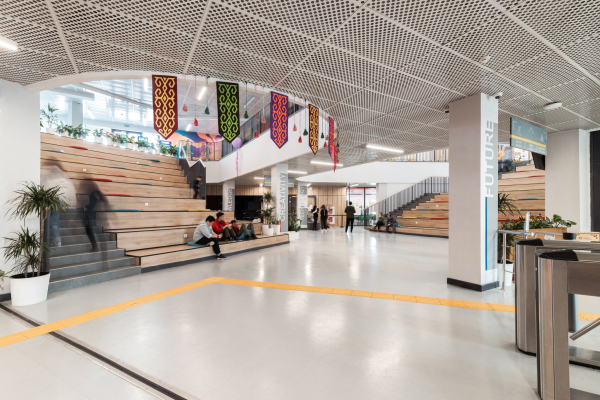 Private school QUANTUMCopyright: Photograph © Evgeny Tkachenko / provided by ATRIUM Architects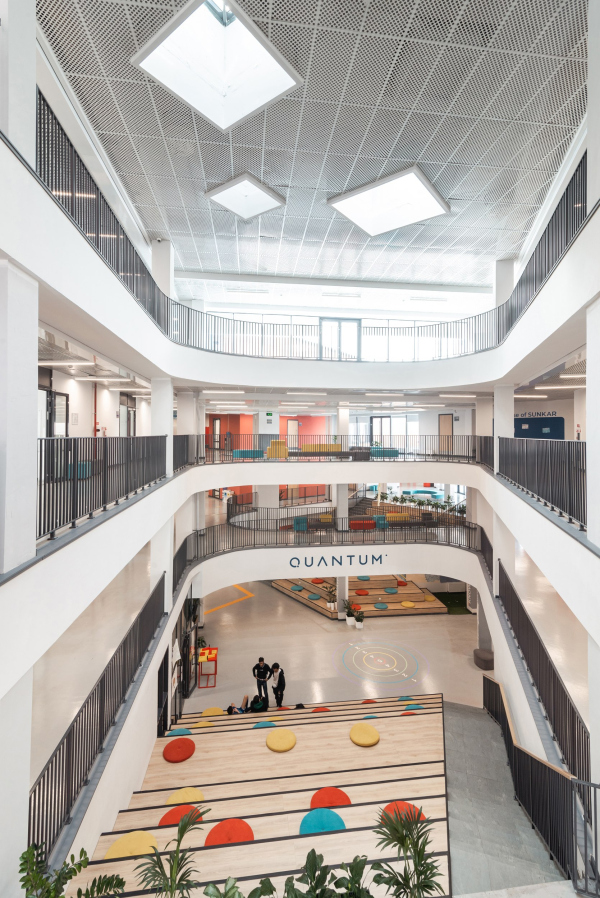 Private school QUANTUMCopyright: Photograph © Evgeny Tkachenko / provided by ATRIUM ArchitectsThere is also a spiral staircase in the same atrium space – as the architects specify, you can ascend to the second floor by the amphitheaters, and then use the spiral staircase to get to the third and fourth. 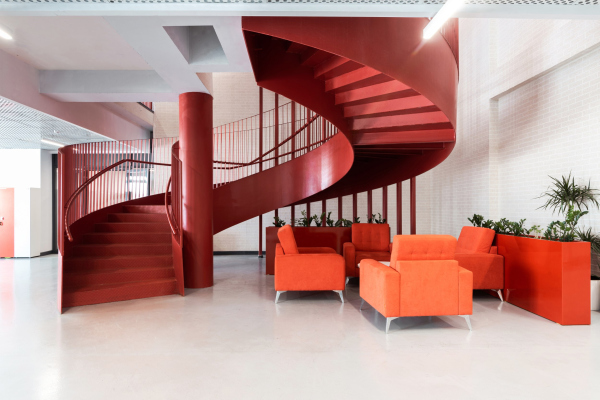 Private school QUANTUMCopyright: Photograph © Evgeny Tkachenko / provided by ATRIUM Architects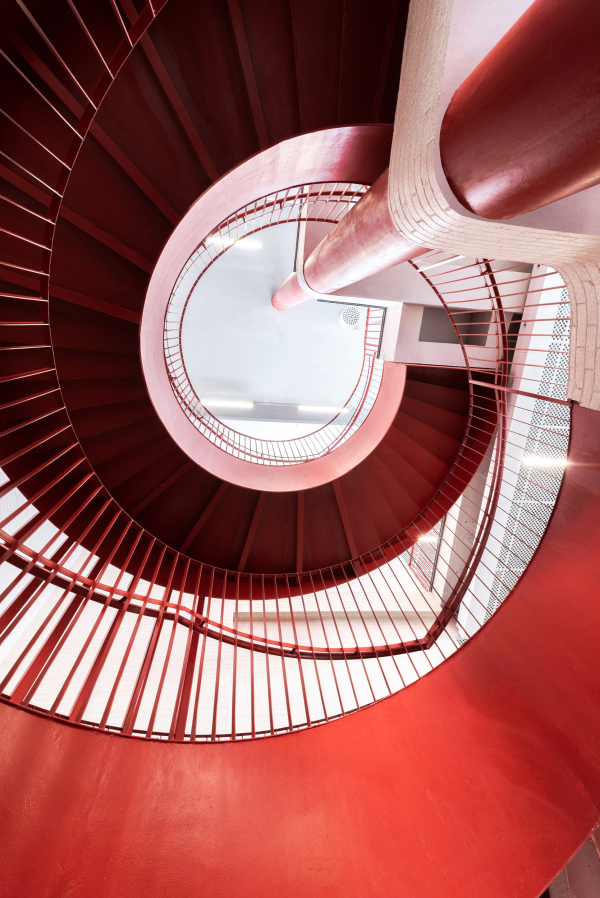 Private school QUANTUMCopyright: Photograph © Evgeny Tkachenko / provided by ATRIUM Architects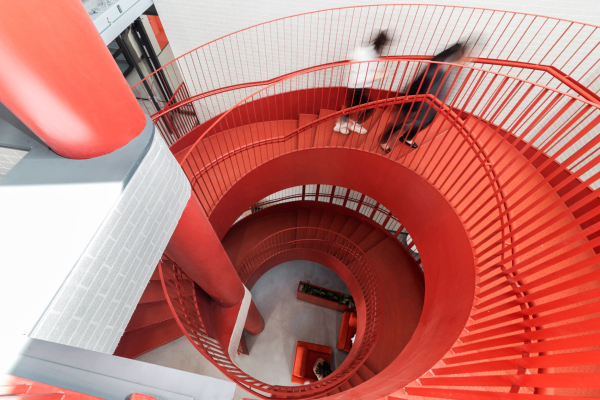 Private school QUANTUMCopyright: Photograph © Evgeny Tkachenko / provided by ATRIUM ArchitectsThe contained-space event hall is, of course, also there in the building; it is placed parallel to the large one consisting of the two amphitheaters in the upper floors of the west unit. The main entrance to it is from the top, from the gallery of the public space. In a word, the center of the building receives a spatial core – I think this is the most adequate term. On the outside, it manifests itself in elevating the glass facades chamfered on the plan: there is a ziggurat that appears in the cavity between the units. On each of the roofs, there is a terrace, on which you can also walk out in summer. There are no skylights, but the atrium is well-lit through glass walls. Private school QUANTUMCopyright: Photograph © Evgeny Tkachenko / provided by ATRIUM ArchitectsThus, the central spatial core “grows through” to the outside world: you can enter and exit at different levels, and the multilevel quality of the inner space is further developed in the landscape forms closest to the building. As we remember, you can exit to the hill from the level of the second floor, having entered on the first and ascending the staircase of one of the amphitheaters: this is how a spatial “loop” appears that connects the outer and the inner spaces. We must remember, however, that the steppe-encircled Astana is a pretty windy place. This is why the hill has not just aesthetic value but it also protects the plaza before the entrance from hard winds that do occur here. The outdoor amphitheaters are made on the slopes of the hill, both on the inside and on the outside. Private school QUANTUMCopyright: Photograph © Evgeny Tkachenko / provided by ATRIUM ArchitectsThe distribution of functions. Private school QUANTUMCopyright: Photograph © Evgeny Tkachenko / provided by ATRIUM ArchitectsCuriously, the landscape – the contours of the hill and the pavement – is subjugated to the pattern of rounded lines that soften the angles of the triangles, which resembles the pavement pattern in the Symbol housing complex. The contours of the galleries in the atrium space are rounded – and this is how yet another kind of echoing appears – this time of the imagery nature – between the landscape on the outside and the public spaces inside.  Private school QUANTUM. Plan of the 1 floorCopyright: Photograph © Evgeny Tkachenko / provided by ATRIUM Architects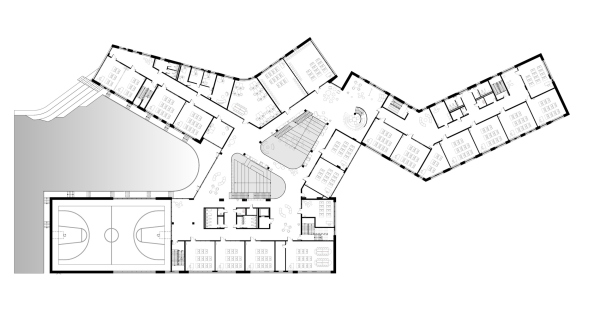 Private school QUANTUM. Plan of the 2 floorCopyright: Photograph © Evgeny Tkachenko / provided by ATRIUM Architects Private school QUANTUM. Plan of the 3 floorCopyright: Photograph © Evgeny Tkachenko / provided by ATRIUM Architects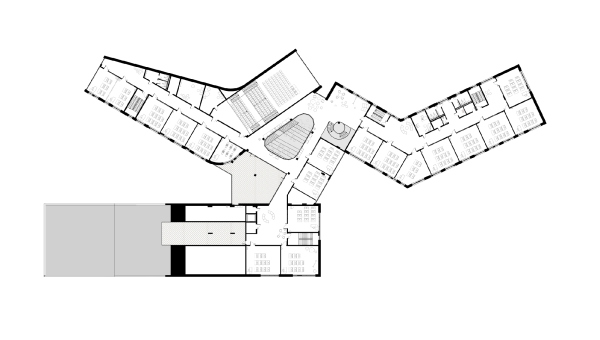 Private school QUANTUM. Plan of the 4 floorCopyright: Photograph © Evgeny Tkachenko / provided by ATRIUM Architects Private school QUANTUM. The master planCopyright: Photograph © Evgeny Tkachenko / provided by ATRIUM ArchitectsMeanwhile, the outlines of the units themselves – asymmetric and rather jagged – are rather based on collisions of planes than on curves. But then again, the construction, which looks almost symmetrical when viewed from one side, looks like a multibeam star on the outside, which is currently considered to be one of the best options for designing a modern school building because it yields a maximum amount of natural sunlight for the classrooms – the building clearly makes the most of the benefits of this approach. 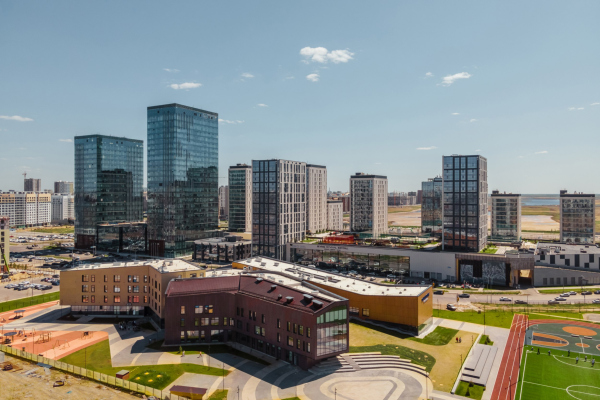 Private school QUANTUMCopyright: Photograph © Evgeny Tkachenko / provided by ATRIUM Architects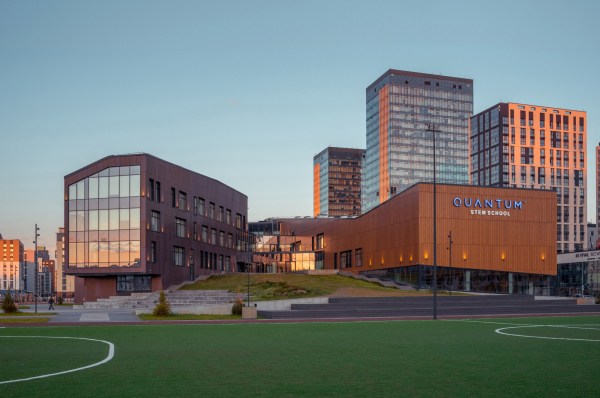 Private school QUANTUMCopyright: Photograph © Evgeny Tkachenko / provided by ATRIUM Architects Private school QUANTUMCopyright: Photograph © Evgeny Tkachenko / provided by ATRIUM Architects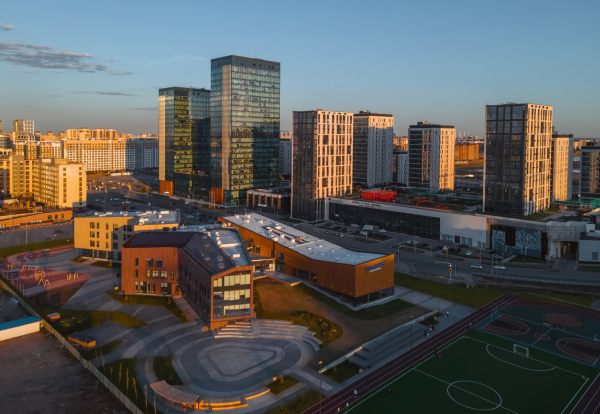 Private school QUANTUMCopyright: Photograph © Evgeny Tkachenko / provided by ATRIUM ArchitectsOn the outside, the units look noticeably different – this helps the students get their bearings – but the contrast is not accentuated; rather, it is aimed at finding “faces of its own”, different and alike at the same time. The junior high unit (grades 6-9) in the center is characterized by a crimson-brownish tone, and greater “flexibility” – this building is the only one here that has a rounded “breaking angle”, and even a pitched roof. Its west pitch is covered with the same material as the facade; the side end of the event hall is encased in a contoured pentagon frame, a characteristic technique of modern architecture during the moments when you suddenly remember that you need to pay tribute to tradition. It even seems to me that this “pitched instance”, the only one in the entire complex, salutes to the dacha houses that survived on a moor to the north of the complex. Probably, they will soon disappear, but their “shadow” as the outline on the sidewall of the school building will remain. 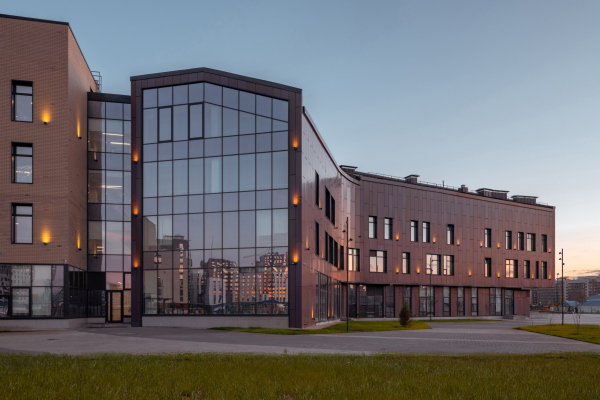 Private school QUANTUMCopyright: Photograph © Evgeny Tkachenko / provided by ATRIUM Architects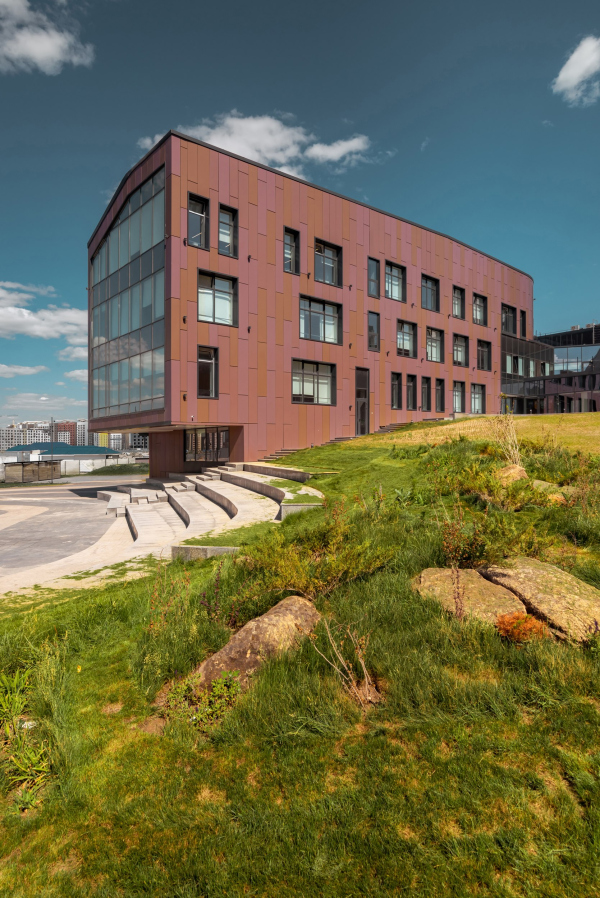 Private school QUANTUMCopyright: Photograph © Evgeny Tkachenko / provided by ATRIUM ArchitectsThe shape of the west unit is the most “tell-tale” of all; it gives the school complex a certain air of coziness, yet it does it very tactfully, staying within the limits of the nuance. The composition, however, is noticeably livened up, and it received a certain intrigue. The other two units have a lighter color. The sports one is decorated with slender vertical panels with a “wood” effect, and the “high school” one is coated with light-colored brick. Their roofs, flat, yet inclined, resonate with each other. Private school QUANTUMCopyright: Photograph © Evgeny Tkachenko / provided by ATRIUM ArchitectsAn important part is played by the cantilevers, there are several of them here, and you can only be surprised and happy with the fact that all these subtleties were implemented to a letter at such a short notice. Without them, the school would have been quite different. And form is something that is very important for a school if you really think of it as a place where personality develops.  Private school QUANTUMCopyright: Photograph © Evgeny Tkachenko / provided by ATRIUM Architects Private school QUANTUMCopyright: Photograph © Evgeny Tkachenko / provided by ATRIUM Architects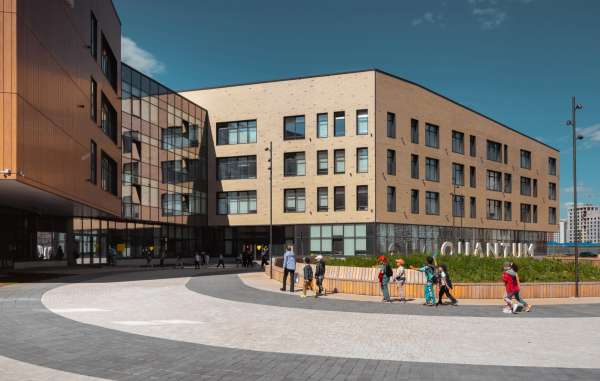 Private school QUANTUMCopyright: Photograph © Evgeny Tkachenko / provided by ATRIUM Architects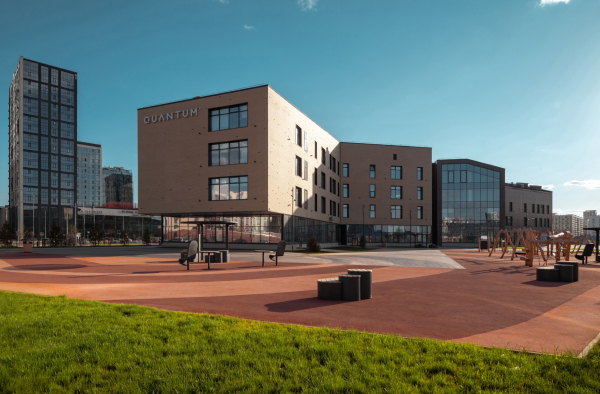 Private school QUANTUMCopyright: Photograph © Evgeny Tkachenko / provided by ATRIUM Architects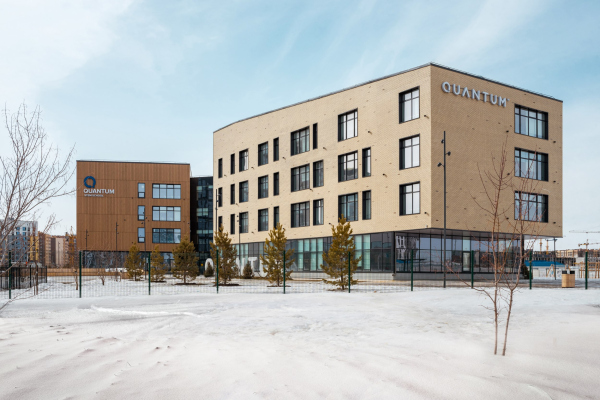 Private school QUANTUMCopyright: Photograph © Evgeny Tkachenko / provided by ATRIUM Architects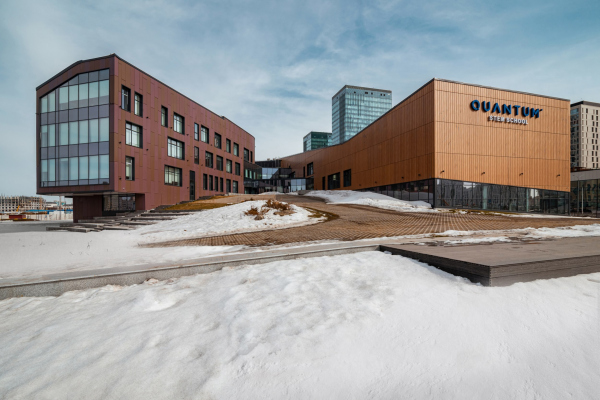 Private school QUANTUMCopyright: Photograph © Evgeny Tkachenko / provided by ATRIUM ArchitectsJust as significant was the client’s request to design a “generally modern” school without any extra specifications. In this day and age, “modern” may mean both globalism and anti globalism, depending how you look at it, expressed in the search for identity that almost inevitably comes down to something overly ornamental, something that looks like a “steppe tent”. Such a search is exciting, yet at the same time there is a risk that it will muddle the process. At the same time, instruction, given in three different languages, is conducive to forming an open-minded worldview. So I think these people are on the right track. The search for the spatial structure and architectural image of the new school is also, I think, productive. Generally speaking, for 10 years, if not more, there has been a lot of talk about how a modern, “efficient” school building can help the growth of personality. These conversations probably date back to the postwar 1950s. Is a building capable of shaping a person, changing him or her for the better, helping to develop with every of its cantilevers, floors, and windows? Something in this equation, of course, depends not only on the building, but also on the person and on other circumstances of his life, both in-school and extracurricular. Meanwhile, Vera Butko and Anton Nadtochiy believe in the healing role of architecture, as it seems, quite sincerely, and are engaged in school projects with full dedication. And they also promised us to show their book about schools pretty soon. |
|
